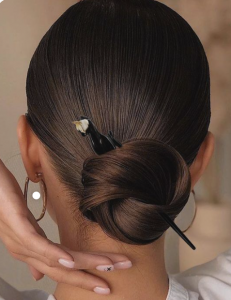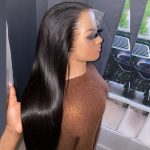Pixie cut wigs have become a popular and stylish choice for individuals looking to experiment with short hair without committing to a real haircut. Creating a pixie cut wig with closure adds a touch of realism and versatility to your style. In this comprehensive guide, we will walk you through the step-by-step process of making a pixie cut wig with closure, ensuring that you achieve a natural and flawless look.
What is a Pixie Cut?
A pixie cut is a short hairstyle characterized by its cropped length, typically exposing the neck and ears. This timeless and versatile cut comes in various styles, ranging from soft and feminine to bold and edgy. Pixie cuts have been popularized by celebrities and fashion icons, making them a classic choice for those seeking a chic and low-maintenance look.
Types of Wigs: Understanding Closures.
In the context of wigs, a closure refers to a small piece of lace or silk with hair attached that is used to mimic a natural hairline. Closures come in different types, including lace closures, lace frontal closures, and silk base closures. The choice of closure impacts the wig’s overall appearance and how it blends with the wearer’s scalp.
Lace Closures: These are small pieces of lace with hair attached. They are typically placed at the center or side of the wig and give a natural appearance to the hairline.
Lace Frontal Closures: These extend from ear to ear, providing a larger area that mimics the natural hairline. They offer versatility in styling as they allow for parting across the entire front of the wig.
Silk Base Closures: Constructed with a layer of silk, these closures give the illusion of a scalp. They are known for their durability and ability to provide a realistic appearance.
Understanding closure types is crucial as it influences how you’ll attach and style your pixie cut wig.
Benefits of Making Your Own Wig.
Crafting your own pixie cut wig with closure offers several advantages:
Personalization: Making your own wig allows you to customize the style, color, and texture of the hair according to your preferences.
Cost-Effectiveness: Creating your wig can be more budget-friendly compared to purchasing a pre-made one, especially if you already have some of the necessary materials.
Skill Development: Wig-making is a valuable skill that you can hone, providing a sense of accomplishment and opening doors to creativity.
Perfect Fit: Designing your wig allows you to tailor it to your head shape and size, ensuring a comfortable and secure fit.
Gathering Materials and Tools.
Gathering the right materials and tools is a crucial step in the process of making a pixie cut wig with closure. Ensuring you have everything you need will contribute to the success of your wig-making project. Here’s a detailed guide on the materials and tools you’ll need:
1. Hair Extensions and Closure Selection.
Hair Extensions: Choose high-quality human hair extensions that match your desired color, texture, and length for the pixie cut. Selecting quality hair ensures a more natural and realistic appearance.
Closure: Depending on your preference, choose a lace closure, lace frontal closure, or silk base closure. The closure should blend seamlessly with the hair extensions and mimic a natural hairline.
2. Wig Cap.
Stretchable Wig Cap: Opt for a wig cap that matches your skin tone for a more realistic look. The wig cap will serve as the base for attaching the hair extensions and closure.
3. Mannequin Head.
Styrofoam or Canvas Mannequin Head: This will be the foundation for styling and crafting the wig. Choose a head that is close to your head size for accurate measurements.
4. T-pins.
T-pins: These are used to secure the wig cap onto the mannequin head, providing stability during the wig-making process.
5. Weaving Needle and Thread.
Curved Weaving Needle: A curved needle is essential for sewing the hair extensions onto the wig cap. It makes the process more manageable.
Matching Thread: Use a strong and durable thread that matches the color of your hair extensions for a seamless finish.
6. Scissors and Shears.
Hair Cutting Shears: High-quality shears are necessary for cutting and styling the hair extensions to achieve the desired pixie cut.
Regular Scissors: Used for cutting the wig cap and making any adjustments as needed.
7. Wig Stand.
Wig Stand: A stand will hold the mannequin head in place during the wig-making process, making it easier to work with.
8. Wig Clips or Combs.
Wig Clips or Combs: These are optional but can be added for extra security when wearing the wig.
Preparing the Mannequin Head.
Preparing the mannequin head is a crucial step in the process of making a pixie cut wig with closure. This stage involves securing the wig cap, positioning the closure, and ensuring that the mannequin head is ready for the subsequent steps. Follow these detailed instructions to prepare the foundation for your customized wig:
1. Securing the Wig Cap.
Materials Needed:
Wig cap
T-pins
Steps:
Place the wig cap over the mannequin head, ensuring it is snug and covers the entire head.
Use T-pins to secure the wig cap in place. Start by pinning the edges of the wig cap around the perimeter of the head.
Add additional T-pins to secure the center of the wig cap, making sure it is taut and free of wrinkles. This will provide a smooth surface for attaching the hair extensions.
2. Positioning the Closure.
Materials Needed:
Closure
T-pins
Steps:
Decide on the desired placement of the closure on the wig cap. Common positions include the center or side, depending on the style you want to achieve.
Use T-pins to secure the closure in place. Pin along the edges of the closure to keep it flat and secure on the wig cap.
Ensure that the closure sits naturally on the wig cap, mimicking a natural hairline. Adjust the position as needed before securing it firmly with T-pins.
3. Attaching the Wig Cap to the Mannequin Head.
Materials Needed:
T-pins
Wig stand
Steps:
Place the wig stand on a stable surface.
Position the mannequin head with the secured wig cap onto the wig stand. Ensure that it is centered and stable.
Use T-pins to attach the wig cap to the wig stand, securing it firmly. This will prevent the wig cap from shifting during the wig-making process.
4. Using T-pins for Stability.
Materials Needed:
T-pins
Steps:
Once the wig cap and closure are in place, use additional T-pins as needed to secure any loose areas or ensure a tight fit.
Check the tension of the wig cap to make sure it is evenly distributed across the mannequin head.
Ensure that the closure remains flat against the wig cap, creating a seamless transition from the wig cap to the closure.

Customizing the Pixie Cut Style.
Customizing the pixie cut style is a creative and crucial step in making your own pixie cut wig with closure. This process involves planning the cut, marking the cutting lines, securing the hair extensions, and finally, cutting and styling the hair. Follow these detailed instructions to achieve the desired pixie cut look:
1. Planning the Pixie Cut Design.
Steps:
Select a Pixie Cut Style: Decide on the specific style of pixie cut you want. Pixie cuts come in various styles, including classic, asymmetrical, layered, and textured. Look for inspiration and choose a style that complements your face shape and personal preferences.
Consider the Closure: Take into account the placement of the closure when planning the pixie cut. The closure should seamlessly blend with the rest of the hair, so plan the cut accordingly.
2. Marking the Cutting Lines.
Materials Needed:
Chalk or washable marker
Steps:
Section the Hair: Divide the hair into manageable sections. Use a comb to create clear partings that define the areas to be cut.
Mark the Cutting Lines: With the chalk or washable marker, mark the cutting lines on each section according to the planned pixie cut style. Be precise in your markings to ensure an even and well-defined cut.
3. Securing the Hair Extensions.
Materials Needed:
Hair clips or ties
Steps:
Secure the Unmarked Sections: Use hair clips or ties to secure the sections of hair that you don’t intend to cut. This will help prevent accidental cutting and ensure a controlled styling process.
4. Cutting and Styling the Hair.
Materials Needed:
Hair cutting shears
Regular scissors
Steps:
Begin Cutting: Starting with one marked section, use the hair cutting shears to cut along the marked lines. Take small sections at a time for more control over the cut.
Check for Symmetry: Regularly check for symmetry as you cut to ensure a balanced and even pixie cut. Make adjustments as needed to maintain a cohesive style.
Blend the Hair Extensions: As you approach the closure area, ensure that the hair extensions blend seamlessly with the closure. Use the scissors to blend and texturize the edges for a natural look.
Texturize and Layer: If your chosen pixie cut style includes layers or texture, use the scissors to add dimension to the hair. This step contributes to the overall natural appearance of the wig.
5. Evaluate and Make Adjustments.
Check for Even Length: After completing the cut, check for any uneven lengths or areas that may need further adjustment. Make any necessary corrections to achieve a polished look.
Evaluate the Style: Assess the overall style of the pixie cut. Ensure that it aligns with your initial vision and that the closure seamlessly integrates with the cut.
Sewing the Hair Extensions.
Sewing the hair extensions onto the wig cap is a meticulous process that requires attention to detail for a natural and seamless appearance. Follow these step-by-step instructions to successfully sew the hair extensions and create the foundation for your pixie cut wig with closure:
1. Creating a Ventilation Pattern.
Materials Needed:
Weaving needle
Thread
T-pins
Steps:
Plan the Ventilation Pattern: Decide on the pattern in which you will sew the hair extensions onto the wig cap. The pattern should be strategic to mimic natural hair growth.
Use T-pins to Secure Sections: Divide the wig cap into sections using T-pins, marking the areas where you will start sewing. This helps maintain organization and control during the process.
2. Using the Weaving Needle and Thread.
Materials Needed:
Curved weaving needle
Matching thread
Steps:
Thread the Needle: Cut a length of thread, and thread it through the eye of the curved weaving needle. Tie a knot at the end of the thread to secure it.
Start Sewing: Begin sewing the hair extensions onto the wig cap, following the planned ventilation pattern. Insert the needle through the weft of the hair extensions and then through the wig cap, creating a secure attachment.
Maintain Tension: Keep a consistent tension while sewing to ensure that the hair extensions lie flat against the wig cap. This prevents an uneven and bulky appearance.
Close the Stitch: When you reach the end of a section, tie a secure knot to close the stitch. Trim any excess thread for a neat finish.
3. Stitching Techniques for a Natural Look.
Single Stitch: The single stitch is the most basic sewing technique. It involves passing the needle through both the weft and the wig cap once before moving to the next stitch. This technique is suitable for most areas of the wig.
Double Stitch: In areas where additional security is needed, consider using a double stitch. Pass the needle through the weft and wig cap twice before moving on to the next stitch. This is especially useful near the closure for added stability.
4. Securing the Closure.
Align the Closure: As you approach the area where the closure is positioned, carefully align the closure with the sewn hair extensions. Ensure that the closure lays flat against the wig cap.
Secure the Closure: Use the same stitching techniques to secure the closure in place. Pay close attention to the edges to create a seamless transition between the closure and the rest of the hair.
5. Repeat the Process.
Continue Sewing: Repeat the process of sewing sections of hair extensions until the entire wig cap is covered. Be patient and meticulous, ensuring each section is securely attached and follows the desired ventilation pattern.
Check for Even Distribution: Regularly check for even distribution of hair across the wig cap. Adjust the tension and stitching as needed to maintain a consistent appearance.
Styling and Shaping the Wig.
Styling and shaping your pixie cut wig with closure is where you bring your vision to life. This step involves refining the pixie cut, texturizing the hair, adding layers and dimension, and creating a natural-looking hairline. Follow these detailed instructions to achieve a polished and stylish appearance:
1. Refining the Pixie Cut.
Materials Needed:
Hair cutting shears
Styling comb
Steps:
Assess the Initial Cut: Evaluate the overall shape of the pixie cut. Use a styling comb to comb through the hair and identify any areas that may need refinement.
Adjusting Length: Use hair cutting shears to trim and adjust the length of the hair as needed. Pay attention to achieving a balanced and even appearance.
Shape the Edges: Refine the edges of the pixie cut to create a clean and well-defined outline. This step contributes to the overall polished look of the wig.
2. Texturizing the Hair.
Materials Needed:
Thinning shears (optional)
Styling comb
Steps:
Create Texture: Use thinning shears to add texture and dimension to the hair. This step is optional but can enhance the natural appearance of the pixie cut.
Thinning Techniques: Take small sections of hair and use the thinning shears to remove bulk. This is particularly useful for areas where you want a softer and more textured look.
3. Adding Layers and Dimension.
Materials Needed:
Hair cutting shears
Styling comb
Steps:
Identify Layering Areas: Determine if you want to add layers to the pixie cut. Layers can add movement and dimension to the wig.
Create Gradual Layers: Use the hair cutting shears to create gradual layers by cutting different sections of hair at varying lengths. This technique adds depth and texture.
Blend Layers Seamlessly: Ensure that the layers blend seamlessly with the rest of the hair. Use the comb to comb through the layers and assess the overall appearance.
4. Creating a Natural Hairline.
Materials Needed:
Styling gel or mousse
Edge brush or comb
Steps:
Apply Styling Product: Use a small amount of styling gel or mousse to smooth and define the edges of the pixie cut. This helps create a natural-looking hairline.
Use an Edge Brush: Use an edge brush or comb to shape the hairline and define the edges. This step adds a finishing touch to the wig, making it look more realistic.
5. Evaluate and Make Final Adjustments.
Check for Balance: Take a step back and evaluate the overall balance and symmetry of the pixie cut. Make any final adjustments to ensure a cohesive and well-styled look.
Personalize the Style: If there are specific features you want to highlight or customize, such as side-swept bangs or a particular parting, now is the time to make those personalized touches.
Last but not the least.
Creating a pixie cut wig with closure is a rewarding and creative process that allows you to express your individual style. By following this comprehensive guide, you’ll be equipped with the knowledge and skills to craft a personalized, natural-looking wig that complements your features and personality. Enjoy the journey of transforming raw materials into a fabulous pixie cut wig that you can proudly wear for any occasion.
















